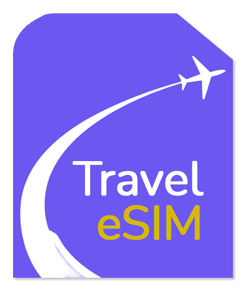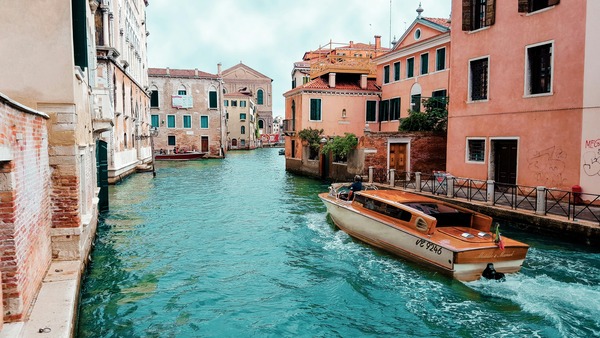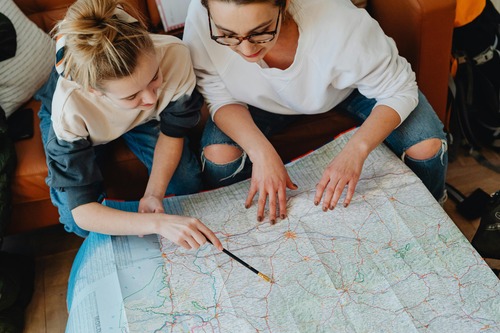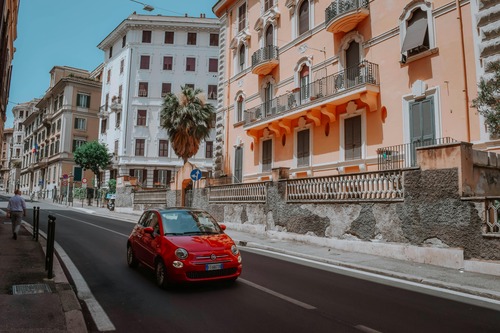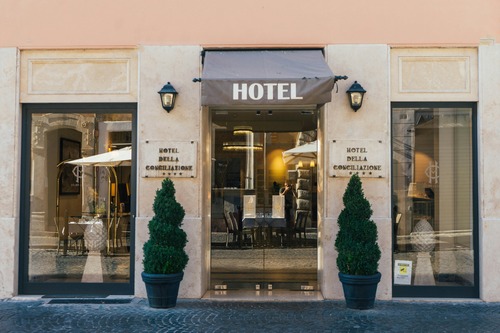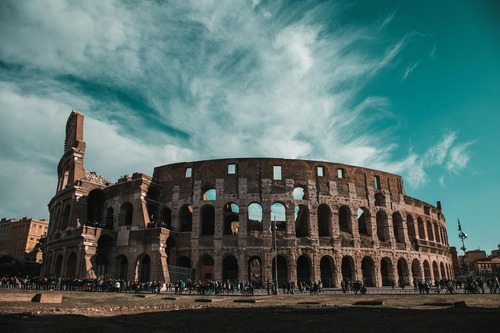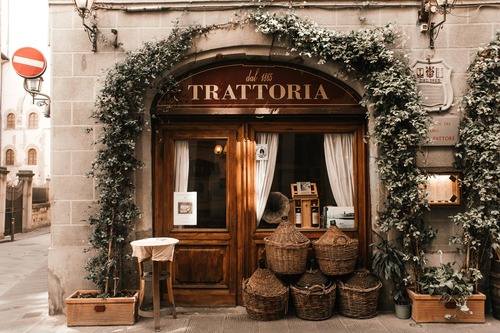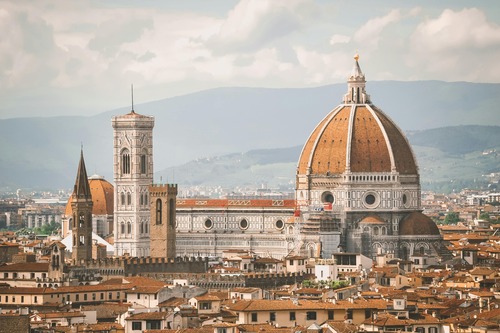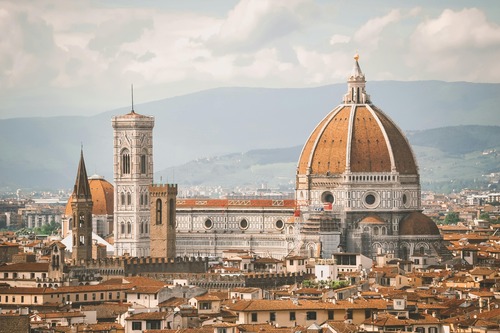Our ultimate travel guide has everything you need to plan the perfect Italian getaway. Inside, you’ll find:
- Insider tips on the best times to visit and how to score amazing deals
- A breakdown of must-see cities and hidden gems waiting to be explored
- Mouthwatering insights into regional cuisines and dining do’s & don’ts
- Vital info on visas, transportation, accommodations, and more
Let’s start with planning…
Planning Your Trip
Passport and Visa Requirements
First, ensure your passport is up to date and has at least six months of validity remaining from your planned return date.
As for visas, it depends on your nationality and the length of your stay. If you’re a citizen of an EU country, you won’t need a visa to enter Italy.
However, if you’re from a non-EU country, you may need to apply for a Schengen visa, which allows you to travel within the Schengen Area for up to 90 days.
Staying Connected in Italy
Mobile Phone Service and Data
Staying connected is important when travelling abroad. Here are some options for mobile phone service and data while in Italy:
Using Your Current Phone Plan
Check with your mobile carrier about international roaming plans and fees. Some carriers offer affordable day passes or travel packages that include data, texts and calling. However, roaming charges can add up quickly so review the details carefully.
Buying a Local SIM Card
Purchasing a prepaid Italian SIM card is a cost-effective way to get local service. TIM, Vodafone, Wind and Iliad are major providers with shops in cities and airports. You’ll need an unlocked GSM phone and your passport to register the SIM card.
Using an eSIM
An eSIM is a digital SIM card that allows you to activate a mobile plan from your phone without having to use a physical SIM card. If your phone supports eSIM technology (like newer iPhones and some Android devices), you can purchase an eSIM data plan online before your trip and activate it upon arrival in Italy.
The best part is:
- There are no passport requirements
- It’s all done online (no visiting stores)
- Activation is instant
- You have internet data as soon as you step off the plane
eSIM providers like buytravelesim.com offer a variety of affordable prepaid data plans for Italy, ranging from 1GB to unlimited.
This is a convenient option if you want to set up service in advance and avoid the hassle of buying a physical SIM card.
Wi-Fi Availability
Many hotels, cafes, restaurants and public spaces in Italy offer free Wi-Fi for customers. However, speeds and reliability can vary. Some larger cities like Rome also have municipal free Wi-Fi in major squares and tourist areas.
If you plan to work remotely or need reliable connectivity, consider booking accommodations with high-speed Wi-Fi and read recent reviews to check for any issues. Purchasing an international data plan or eSIM can provide a backup option if Wi-Fi is slow or unavailable.
Useful Apps for Travelers
Best Time to Visit Italy
Italy has a Mediterranean climate, with hot, dry summers and cool, wet winters. The best time to visit depends on your preferences and the activities you have in mind.
Peak Season
- Summer (June-August, excluding August in cities)
- Major holidays like Christmas, New Year’s, and Easter
- Extremely crowded and the most expensive time to visit
- Hot temperatures, especially in southern regions
Shoulder Seasons
- Spring (March-April)
- Fall (Late October-November)
- Mild weather and fewer crowds than peak season
- Good chance of finding deals on accommodation and flights
Off-Peak/Low Season
- Winter (November-February, excluding holiday periods)
- Cooler, wetter weather
- Fewest crowds and lowest prices
- Some attractions/restaurants may have reduced hours or be closed
Peak and Off-Peak Seasons
Peak season in Italy coincides with the summer months (June to August) and major holidays like Christmas, New Year’s, and Easter. During these times, expect higher prices, larger crowds, and longer queues at popular attractions.
The off-peak season falls during the winter months (November to March, excluding the holiday periods).
While the weather may be colder and wetter, you’ll find lower prices and fewer tourists making it a great time to explore Italy’s cities and museums without the hassle of navigating through throngs of people.
Budget Planning
Accommodation Costs
Accommodation costs in Italy vary depending on the type of lodging, location, and time of year.
In major cities like Rome, Florence, and Venice, expect to pay more for hotels and vacation rentals compared to smaller towns and rural areas.
- Mid-range hotel rooms typically cost €120 per night on average.
- Hostel dorm beds range from €29 to €46 per night.
- Private hostel rooms cost €90 to €170 per night.
- Accommodation is more expensive in major cities like Rome, Florence, and Venice compared to smaller towns.
- Vacation rentals like Airbnb can be cost-effective, ranging from €50 to €150 per night.
- Prices vary significantly based on location within a city, time of year, and accommodation type.
Transportation Costs
Getting around Italy can be relatively affordable, especially if you plan ahead.
Train travel is a convenient and popular way to get around Italy, with options ranging from high-speed trains to slower regional trains.
Prices for train tickets vary based on factors like speed, distance, and class of service. For example:
- A one-way ticket from Rome to Florence on a high-speed train can cost €30-€50.
- A slower regional train for the same route may cost around €20.
For city transportation, single tickets for buses, trams, and metros typically cost €1-€2.
Purchasing day passes or multi-day passes for public transportation in cities can help save money if using it frequently.
Italy offers some rail pass options like the Eurail Italy Pass which provides unlimited travel for a set number of days within a month, which can be cost-effective for extensive train travel.
Food and Drink Expenses
One of the joys of visiting Italy is indulging in its delicious cuisine. However, dining out can quickly add up.
- Eat at Trattorias or Osterias: Trattorias and osterias are casual, inexpensive restaurants that serve traditional Italian cuisine. A meal at one of these establishments will typically cost €10-20 per person, much less than a mid-range or high-end restaurant.
- Have Meals at Different Times: Italians tend to eat later than many tourists. Having lunch around 1-2pm and dinner around 8-9pm can allow you to take advantage of prix fixe menus or other meal deals before or after the peak hours.
- Order the Primo Only: Rather than getting an antipasto, primo, secondo, and dolce, just order a primo (first course pasta or risotto dish) which can be quite filling on its own for €8-12.
- Seek Out Pizzerias: Pizzerias offer very affordable options, with a whole pizza often costing €6-10. Avoid places with tourist menus or people trying to pull you in from the street.
- Visit Local Markets: Shopping at local food markets and grocery stores allows you to put together affordable picnic lunches with fresh local ingredients like cheese, cured meats, bread, fruits and vegetables.
- Split Dishes: Italian portions, especially for antipasti and primi, can be quite large. Consider sharing dishes with your dining companions to save money.
On average, a meal at a mid-range restaurant can cost around €25 to €35 per person, while a meal at a high-end restaurant might set you back €50 or more.
Activity and Attraction Fees
Many of Italy’s famous attractions, such as the Colosseum in Rome or the Uffizi Gallery in Florence, charge entrance fees.
Here’s a quick breakdown of the attractions and fees (at the time of writing):
- Famous attractions like the Colosseum in Rome and Uffizi Gallery in Florence charge entrance fees, typically ranging from €10 to €25 per person.
- Combination tickets or city passes can provide discounted admission to multiple attractions. For example, the Rome & Vatican Pass covers the Colosseum, Vatican Museums, and other sites.
- Many state-run museums and galleries in Italy offer free admission on the first Sunday of the month. This can be a way to visit major sites for free.
- EU citizens may be eligible for reduced admission fees at some attractions, especially those under 25 years old. The rules vary by venue.
- Children under a certain age (e.g. 6 or 18 depending on the attraction) may receive complimentary admission if they are EU citizens.
- Skip-the-line tickets, which allow you to bypass entrance queues, tend to be more expensive than basic admission.
Language Basics
Greetings
- Hello / Hi: Ciao, Salve
- Good morning: Buongiorno
- Good afternoon: Buon pomeriggio
- Good evening: Buonasera
- Goodbye: Arrivederci, Ciao
Polite Expressions
- Please: Per favore
- Thank you: Grazie
- You’re welcome: Prego
- Excuse me: Scusi, Permesso
- I’m sorry: Mi dispiace
- No problem: Non c’è problema
Basic Phrases
- Yes: Sì
- No: No
- I don’t understand: Non capisco
- Do you speak English?: Parla inglese?
- Where is the bathroom?: Dov’è il bagno?
- Speak slowly: Parli lentamente
- Have a good day: Buona giornata
Introductions
- Nice to meet you: Piacere
- My name is : Mi chiamo
Language Learning Resources
If you want to dive deeper into learning Italian before your trip, there are plenty of resources available. Consider using language learning apps like Duolingo or Babbel, which offer interactive lessons and exercises. You can also find Italian language courses at local community centres, universities, or online platforms like Rosetta Stone or Pimsleur.
Flights
Italy has several major international airports, including:
- Leonardo da Vinci International Airport (FCO) in Rome
- Milano Malpensa Airport (MXP) in Milan
- Marco Polo International Airport (VCE) in Venice
- Pisa International Airport (PSA) in Pisa
When booking your flights, compare prices across different airlines and consider factors like layovers, baggage allowances, and travel times.
Keep an eye out for deals and promotions, especially during off-peak seasons.
Train Travel from Neighboring Countries
If you’re already in Europe, travelling to Italy by train can be a scenic and enjoyable alternative to flying.
High-speed rail networks connect Italy with neighbouring countries like France, Switzerland, Austria, and Slovenia. Some popular train routes include:
- Paris to Milan or Venice via the TGV and Frecciarossa trains
- Zurich to Milan via the EuroCity trains
- Vienna to Venice via the ÖBB Nightjet sleeper trains
When planning your train journey, book your tickets in advance to secure the best prices and seat reservations.
Getting Around Italy
Domestic Flights
If you’re short on time and need to cover long distances quickly, domestic flights can be a good option.
Low-Cost Airlines for Domestic Flights in Italy
- Ryanair and easyJet are two major low-cost European airlines that operate domestic flights within Italy.
- Ryanair flies between cities like Rome, Milan, Naples, Bari, Cagliari, and others.
- EasyJet serves over 15 domestic destinations in Italy from its bases in Milan, Naples, and Venice.
- These budget airlines offer affordable options for domestic travel within Italy.
Factors to Consider for Domestic Flights
- Domestic flights in Italy are short-haul, with flight times generally under 1 hour 45 minutes even for the longest routes.
- While flying can save time over long distances, there are additional factors like travel to/from airports, security checks, and potential delays that can offset the time savings.
- For shorter distances or when not pressed for time, alternative modes of transport like trains or driving may be more efficient than domestic flights within Italy.
Train Travel
Trains are a fantastic option when travelling around Italy, here’s a quick breakdown of the train system.
Train Companies in Italy
- Trenitalia is the primary national railway company in Italy, operating high-speed, regional, and intercity trains.
- Italo is a private high-speed train operator that connects major cities like Rome, Milan, Venice, Florence, and Naples.
High-Speed Trains
- Frecciarossa (Trenitalia) and Italo trains are the fastest, reaching speeds up to 300 km/h.
- They quickly connect major cities – for example, Rome to Florence takes just over 1 hour.
- High-speed trains are the most comfortable but also more expensive than regional or intercity trains.
Regional and Intercity Trains
- Trenitalia operates slower regional trains that stop at smaller towns across Italy.
- Intercity trains are slightly faster than regional trains and connect major cities with fewer stops.
- Regional and intercity trains are more affordable options for shorter distances.
Booking Tickets and Seat Reservations
- Train tickets can be booked up to 180 days in advance on the Trenitalia website or through rail agents.
- Seat reservations are mandatory on high-speed and intercity trains but not required for regional trains.
- Regional train tickets are valid for 2 months from the purchase date.
Car Rental
Renting a car can offer greater flexibility and freedom to explore Italy at your own pace, especially if you plan on visiting rural areas or smaller villages not well-served by public transportation.
However, driving in Italy can be challenging, especially in major cities with heavy traffic, limited parking, and ZTL (Zona a Traffico Limitato) restricted zones.
Tips for Renting a Car in Italy
- Book well in advance, especially for automatic transmission cars which have limited availability.
- Pick up and drop off at airports to avoid city centre traffic and have more vehicle options.
- Consider smaller, compact cars better suited for narrow Italian roads.
- Plan parking in advance, opt for accommodations with parking and understand parking rules.
- Document the car’s condition thoroughly at pick up and return to avoid disputes.
- Be prepared for aggressive driving styles, especially on highways.
- Weigh the pros and cons – guided tours may be preferable for some destinations.
Accommodation
Types of Accommodation
When it comes to finding a place to rest your head in Italy, you’ve got plenty of options. Let’s take a look at some of the most popular choices:
Hotels
Hotels are a classic choice for travellers, and Italy has no shortage of them. From budget-friendly 1-star hotels to luxurious 5-star resorts, there’s a hotel in Italy for every taste and budget. Many hotels offer amenities like on-site restaurants, fitness centres, and concierge services.
Hostels
If you’re travelling on a tight budget or looking to meet fellow adventurers, hostels might be the way to go. These shared accommodations often feature dormitory-style rooms, communal kitchens, and social spaces. Some hostels even offer private rooms for a bit more privacy.
Vacation Rentals
Vacation rentals, like those found on Airbnb or VRBO, have become increasingly popular in recent years. Renting an apartment or villa can give you more space, privacy, and the chance to live like a local. Plus, having a kitchen can help you save money on dining out.
Agriturismos
Fancy staying on a working farm or vineyard? Then an agriturismo might be right up your alley. These rural accommodations offer a unique opportunity to experience Italian country life, often with delicious homemade meals and local wine included during your Italy trip.
Booking Tips and Recommendations
Now that you know your options, here are some tips to help you score the perfect place to stay:
- Book early: Popular destinations and high-season dates can fill up quickly, so it pays to plan ahead.
- Read reviews: Before booking, check out reviews from previous guests to get a sense of what to expect.
- Consider location: Do you want to be in the heart of the action or somewhere more peaceful? Think about your priorities and choose accordingly.
- Compare prices: Don’t just book the first place you see. Shop around and compare prices across different platforms to find the best deal.
- Look for deals: Many accommodations offer discounts for longer stays, off-season bookings, or last-minute reservations.
- Check for extra fees: Be aware of additional costs like city taxes, cleaning fees, or security deposits.
- Confirm amenities: Make sure the accommodation has everything you need, whether that’s Wi-Fi, air conditioning, or a washing machine.
Itinerary Planning
Popular Cities and Regions
Italy is brimming with incredible destinations, each offering its own unique charm and character. Here are some of the most popular cities and regions you won’t want to miss:
- Rome: The Eternal City is a must-see, with iconic landmarks like the Colosseum, Vatican City, and the Trevi Fountain.
- Florence: This Renaissance gem is home to world-class art museums, stunning architecture, and mouth-watering Tuscan cuisine.
- Venice: Get lost in the maze of canals and alleyways, admire the colourful houses of Burano, and soak up the romantic atmosphere.
- Milan: Italy’s fashion capital also boasts impressive museums, galleries, and the awe-inspiring Duomo Cathedral.
- Amalfi Coast: This picturesque coastline is dotted with charming villages, lemon groves, and dramatic cliffs.
- Cinque Terre: These five colourful fishing villages are a hiker’s paradise, with stunning trails and breathtaking sea views.
- Tuscany: Rolling hills, medieval towns, and world-famous wineries make this region a favourite among travellers.
Suggested Itineraries
With so much to see and do, it can be tough to plan the perfect itinerary. Here are a few suggestions to help you make the most of your time in Italy:
7-Day Highlights Tour
- Day 1-2: Rome (Colosseum, Vatican City, Trevi Fountain)
- Day 3-4: Florence (Uffizi Gallery, Duomo, Ponte Vecchio)
- Day 5: Pisa (Leaning Tower) and Cinque Terre
- Day 6-7: Venice (St. Mark’s Square, Doge’s Palace, Murano)
14-Day Comprehensive Tour
- Day 1-3: Rome (Colosseum, Vatican City, Trevi Fountain, Pantheon) – a great start to any Italy trip.
- Day 4-6: Florence (Uffizi Gallery, Duomo, Ponte Vecchio, Tuscany day trip)
- Day 7-8: Cinque Terre (Hiking, villages, beaches)
- Day 9-11: Venice (St. Mark’s Square, Doge’s Palace, Murano, Burano)
- Day 12-13: Amalfi Coast (Positano, Amalfi, Ravello)
- Day 14: Naples (Pompeii, pizza)
City-Specific Itineraries
If you’re focusing on a specific city, here are some ideas for how to spend your time:
- Rome (3-4 days): Colosseum, Roman Forum, Vatican City, Trevi Fountain, Spanish Steps, Pantheon, Borghese Gallery
- Florence (2-3 days): Uffizi Gallery, Accademia Gallery (David), Duomo, Ponte Vecchio, Pitti Palace, Boboli Gardens
- Venice (2-3 days): St. Mark’s Square, Doge’s Palace, Rialto Bridge, Murano, Burano, Gondola ride
Off-the-Beaten-Path Destinations
While Italy’s major cities are undeniably incredible, there’s so much more to discover beyond the beaten path. Here are a few hidden gems to add to your itinerary:
- Bergamo: This charming medieval town near Milan boasts a stunning hilltop old city and beautiful architecture.
- Matera: This ancient cave city in southern Italy is a UNESCO World Heritage site and a truly unique destination.
- Puglia: This sun-drenched region in the heel of Italy’s boot is known for its whitewashed villages, stunning beaches, and delicious cuisine.
- Sardinia: This rugged island off the coast of Italy offers pristine beaches, crystal-clear waters, and a laid-back vibe.
Remember, these are just a few ideas to get you started. The beauty of Italy is that there’s always something new to discover, whether you’re a first-time visitor or a seasoned traveller. So don’t be afraid to venture off the beaten path and create your own unforgettable itinerary!
Food and Drink
Italian Cuisine Overview
One of the most exciting parts of any trip to Italy is the chance to indulge in the country’s legendary cuisine.
From creamy risottos to crispy pizzas, and hearty pasta to decadent desserts, Italian food is all about simple, high-quality ingredients and time-honoured traditions.
But Italian cuisine is more than just pizza and pasta. Each region has its unique culinary specialties and flavours, shaped by local history, geography, and culture.
Regional Specialties
The food in Italy changes depending on where you are and if you’re a lover of wine then it’s also best to select wine from that specific region.
Let’s take a closer look at some of the mouth-watering dishes you’ll find in different parts of Italy:
- Tuscany: Known for its rustic, hearty fare like ribollita (vegetable soup), bistecca alla fiorentina (grilled T-bone steak), and pappardelle al cinghiale (pasta with wild boar sauce).
- Emilia-Romagna: Home to some of Italy’s most iconic dishes, including lasagne, tortellini, Parmigiano-Reggiano cheese, and balsamic vinegar from Modena.
- Campania: Famous for its pizza napoletana, mozzarella di bufala, and limoncello liqueur.
- Sicily: Offers a unique fusion of Italian, Greek, and Arab influences, with dishes like arancini (stuffed rice balls), pasta alla Norma, and cannoli pastries.
- Veneto: Renowned for its seafood, risotto, and Cicchetti (small snacks or side dishes).
Of course, this is just a small taste of the incredible diversity of Italian cuisine. No matter where you go, you’re sure to find delicious new dishes to try and savour.
Dining Etiquette
While Italians are generally a laid-back bunch, there are a few dining customs and etiquette tips to keep in mind:
Pace and Structure of Meals
- Meals, especially dinner, are meant to be enjoyed slowly over multiple courses and with good company. Don’t rush through the meal.
- A typical Italian meal follows this structure: antipasto (appetizer), primo (pasta/rice course), secondo (meat/fish course) with contorno (side dish), dolce (dessert), and coffee.
Ordering and Eating Specific Items
- Do not order a cappuccino with a meal, only for breakfast. Order an espresso (caffè) instead.
- Do not put cheese (like Parmesan) on seafood dishes or pasta with certain sauces where it would overpower the flavours.
- Use bread to soak up the remaining sauce on your plate, a practice known as “fare la scarpetta.” This shows appreciation for the food.
- Twirl long pasta like spaghetti onto your fork, don’t cut it.
Dining Etiquette
- Make eye contact when toasting to show respect.
- Don’t toast with water, as it’s considered unlucky.
- Let the host/senior members of the party be seated first.
- Don’t rush the waiter or expect extremely quick service.
Wine Etiquette
- Pair red wines with red meat/tomato sauces, and white wines with fish/vegetables.
- Don’t mix light wines like Pinot Grigio with heavy red meats.
Restaurant Recommendations
With so many incredible restaurants to choose from, it can be hard to know where to start. Here are a few recommendations for must-try dining experiences in Italy:
Rome
- Ristorante All’Oro (Michelin-starred, reinvented Roman cuisine)
- Giuseppe di Iorio Aroma (rooftop restaurant with views of the Colosseum)
Amalfi Coast
- Lo Scoglio (coastal classics like caprese salad, gnocchi alla sorrentina in a scenic seaside village)
- Grotta Palazzese, Polignano a Mare (stunning location built into a grotto)
- La Sponda, Positano (romantic setting at Le Sirenuse hotel with mesmerizing views)
Capri
- Il Riccio (Michelin-starred casual seafood restaurant with a beach club)
Puglia
- Volta del Fuenti, Vietri sul Mare (contemporary creativity with historical influences)
Sicily
- La Foresteria at Planeta Estate (world-famous Sicilian cuisine with vineyard and coastal views)
Palermo
- Villa Igiea (luxury hotel with outstanding dining options)
Abruzzo
- Ristorante Reale (3 Michelin stars, transforming stellar ingredients into edible art)
Ravello
- Hotel Caruso (stunning setting perched above the Amalfi Coast)
Of course, some of the best meals in Italy are often found in small, unassuming trattorias or even street food stalls. Don’t be afraid to explore and follow your nose to find hidden gems.
Food Tours and Cooking Classes
If you want to dive even deeper into Italian cuisine, consider signing up for a food tour or cooking class.
Many cities offer guided tours that take you to local markets, specialty shops, and restaurants to sample regional delicacies and learn about the history and culture behind them, enhancing your Italy travel experience.
Cooking classes are another great way to immerse yourself in Italian culinary traditions. You’ll learn how to make classic dishes like homemade pasta, tiramisu, or pizza from scratch, often using fresh, locally sourced ingredients.
Plus, you’ll get to enjoy the fruits of your labour at the end of the class! Whether you’re a foodie or just appreciate a good meal, one thing’s for sure: eating your way through Italy is an adventure you won’t soon forget. So, loosen your belt, grab a fork, and get ready to savour every delicious bite!
Activities and Attractions
Historical and Cultural Sites
Italy is a treasure trove of historical and cultural wonders, with countless museums, churches, and ancient ruins to explore. Here are a few must-see sites:
Museums
- Vatican Museums (Rome): Home to an incredible collection of art and artifacts, including the Sistine Chapel and Raphael Rooms.
- Uffizi Gallery (Florence): One of the world’s most famous art museums, with masterpieces by Leonardo da Vinci, Botticelli, and Michelangelo.
- Galleria Borghese (Rome): A stunning villa housing an impressive collection of sculptures and paintings by Bernini, Caravaggio, and Titian.
Churches and Cathedrals
- St. Peter’s Basilica (Vatican City): The largest church in the world and the centre of the Catholic faith.
- Duomo di Milano (Milan): A massive Gothic cathedral that took nearly six centuries to complete.
- Basilica di San Marco (Venice): A stunning example of Byzantine architecture, with glittering mosaics and intricate carvings.
Ancient Ruins
- Colosseum (Rome): An iconic symbol of ancient Rome, where gladiators once battled before crowds of thousands.
- Pompeii (near Naples): A fascinating archaeological site that offers a glimpse into daily life in ancient Roman times.
- Pantheon (Rome): A remarkably well-preserved temple that has stood for nearly 2,000 years.
Outdoor Activities
While Italy is known for its cities and cultural attractions, it also offers plenty of opportunities for outdoor adventure. Here are a few ideas:
- Hiking in the Dolomites: This stunning mountain range in northern Italy offers breathtaking views and trails for all skill levels.
- Cycling in Tuscany: Pedal through picturesque hills, vineyards, and medieval villages on a guided or self-guided bike tour.
- Swimming in the Amalfi Coast: Take a dip in the crystal-clear waters of the Mediterranean, or relax on one of the many beautiful beaches.
- Skiing in the Alps: If you’re visiting in winter, hit the slopes at one of Italy’s many world-class ski resorts, like Cortina d’Ampezzo or Courmayeur.
Shopping
Italy is a shopper’s paradise, with everything from high-end designer boutiques to local artisan markets. Here are a few spots to check out:
- Via Montenapoleone (Milan): This famous shopping street is home to luxury brands like Prada, Gucci, and Versace.
- Mercato Centrale (Florence): A bustling indoor market where you can find fresh produce, meats, cheeses, and local specialties.
- Murano (Venice): This small island is famous for its handblown glass, with dozens of workshops and showrooms to explore.
Festivals and Events
No matter when you visit, there’s always something happening in Italy. Here are a few notable festivals and events:
- Carnival (February/March): Celebrated throughout Italy, but especially famous in Venice, with elaborate costumes and masks.
- Palio di Siena (July/August): A historic horse race that takes place in the city’s main square, with colorful pageantry and fierce rivalries.
- Festa della Repubblica (June 2): Italy’s national day, celebrated with parades, concerts, and fireworks displays.
- Festa di San Gennaro (September): A lively religious festival in Naples, with processions, music, and street food.
These are just a few of the many activities and attractions Italy has to offer. Whether you’re interested in art, history, food, or adventure, you’ll find plenty to keep you busy and entertained. Don’t be afraid to explore off the beaten path and create your own unique experiences!
Emergency Contacts
In case of an emergency, it’s important to know who to contact for help. Here are some key emergency numbers to keep handy:
- Police: 112
- Ambulance: 118
- Fire Brigade: 115
You can also contact your country’s embassy or consulate in Italy for assistance with lost passports, legal issues, or other emergencies.
Travel Insurance
As mentioned earlier, travel insurance is a must when visiting Italy. Look for a comprehensive policy that covers:
- Medical expenses and emergency evacuation
- Trip cancellation or interruption
- Lost, stolen, or damaged belongings
- Personal liability
Be sure to read the fine print and understand any exclusions or limitations before purchasing a policy. Some credit cards also offer travel insurance as a perk, so check with your card issuer to see if you’re already covered. Navigating the practicalities of travel in Italy doesn’t have to be daunting. With a bit of preparation and common sense, you can enjoy a safe, healthy, and hassle-free trip. Don’t forget to take plenty of photos, soak up the culture, and savor every moment of your Italian adventure!
Cultural Insights
Italian Customs and Etiquette
Importance of Family
Italians have close-knit families and value spending time together, especially over meals. If invited to an Italian home for dinner, bring a small gift and be prepared for a long evening.
Dressing Well
Italians take pride in their appearance and tend to dress up more than Americans or other Europeans. Pack nice, versatile outfits suitable for both sightseeing and dining out.
Greetings and Formalities
Greetings are more formal in Italy. A handshake is common when first meeting someone. Friends and family may greet each other with a kiss on both cheeks, starting with the left. Italians often use formal titles like “signore” (sir) or “signora” (madam) as a sign of respect.
Dos and Don’ts
To help you navigate Italian culture like a pro, here are a few key dos and don’ts to keep in mind: Do:
- Learn a few basic Italian phrases, like “per favore” (please) and “grazie” (thank you)
- Dress modestly when visiting churches or religious sites (covered shoulders and knees)
- Enjoy long, leisurely meals and savour each course
- Embrace the Italian love of coffee and enjoy a cappuccino or espresso at a local bar
- Be respectful of local customs and traditions, even if they differ from your own
Don’t:
- Wear shorts, tank tops, or flip-flops when dining out or visiting churches
- Touch or take photos of artwork or artifacts in museums without permission
- Expect stores or restaurants to be open all day (many close for a few hours in the afternoon)
Interacting with Locals
One of the joys of travelling is the opportunity to meet and interact with locals. Italians are generally very friendly and happy to chat with visitors, especially if you make an effort to speak a bit of Italian.
If you’re looking to strike up a conversation, try starting with a compliment or observation about the local area. Italians are proud of their hometowns and love to share their favourite spots and stories with visitors.
Just be sure to avoid controversial topics like politics or religion, and don’t take offence if an Italian is a bit more direct or opinionated than you’re used to – it’s just part of the culture.
Another great way to connect with locals is through food and drink.
Italians love to share their culinary traditions with visitors, so don’t be shy about asking for recommendations or striking up a conversation with your waiter or bartender.
You may just end up with a new friend and some insider tips on the best spots to eat and drink like a local.
The key to enjoying Italian culture is to approach it with an open mind and a willingness to embrace new experiences. Whether you’re navigating a crowded piazza or savouring a plate of homemade pasta, remember to slow down, and savour the moment.
